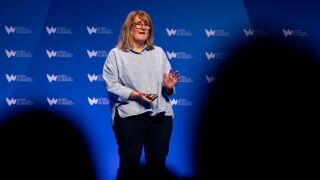The new solution leverages mobile assets in 170 countries with permanent roaming options in North America and Western Europe all on a single SIM. As a result, organisations can manage a range of IoT devices including asset trackers, industrial gateways and sensors using ThingSpace, Verizon’s self-service IoT platform.
“The Internet of Things is changing the way businesses monitor devices and increasing the strategic business value of the data collected,” said Tami Erwin (pictured), CEO at Verizon Business.
“The number of IoT devices is growing exponentially and organisations prefer to align with a trusted technology partner who can offer the technical expertise and geo-scale they require. Our global IoT connectivity services are all underpinned by Verizon’s years of expertise and industry leading ThingSpace platform, not to mention a path to evolving into 5G Massive IoT.”
Verizon’s IoT device connectivity is available globally to US multinational companies with fixed or mobile connectivity requirements. In addition, businesses can deploy devices with permanent roaming across Canada, the UK and 10 additional European markets.
In related news, Verizon is also preparing for a 5G Ultra Wideband expansion across its newly acquired national footprint of C-band spectrum.
Most recently, Verizon partnered Ericsson and MediaTek to aggregate C-band spectrum with mmWave spectrum, achieving speeds of 4.3Gbps in the trial.
“The depth of our spectrum portfolio, now the strongest in the industry, allows us to quickly expand access to a world-class 5G experience for our mobile and fixed broadband customers, providing high speeds, low latencies and enormous capacity,” said Adam Koeppe, senior vice president of technology planning at Verizon.
“These lab trials demonstrate the exceptional network performance our customers will receive as we are able to integrate our newly acquired C-band spectrum with mmWave spectrum.”
Verizon has already begun installing C-band equipment from Ericsson and Samsung Electronics, to enable the rapid deployment of its 5G Ultra Wideband and fixed wireless broadband service.
The company expects to rollout new 5G C-band spectrum across 46 markets and to provide 5G Ultra Wideband service to 100 million people by Q1 of 2022. Over 2022 and 2023, this coverage is expected to increase to more than 175 million people and by 2024, when the remaining C-band spectrum is cleared, more than 250 million people.






